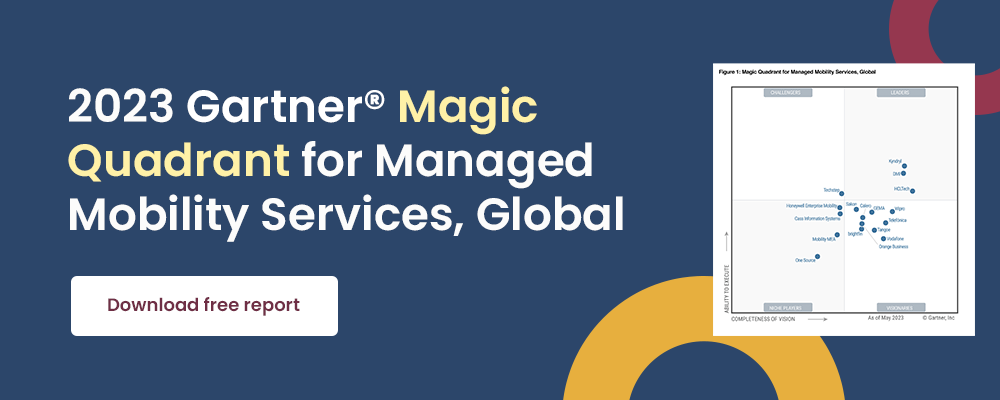|
In an age of rapid technological advancement, the public sector faces a vital challenge: embracing digital transformation to improve citizen services. Mobile technology, in particular, plays an important role in unlocking heighten efficiency and accessibility. However, the path towards digitalising the public sector is filled with challenges that demands meticulous consideration and strategic solutions.
|
This article marks the beginning of a three-part series. Find the complete set of articles here:
- Digital Transformation in the Public Sector: Navigating a Complex and Diverse Mobile Workforce
- Scale Mobile Device Usage in the Public Sector – A Blueprint for Success
- Mobile Technology Procurement - A Guide to Device Lifecycle Management, Endpoint Management, and Security in the Public Sector
|
A Diverse Set of Roles
The public sector, when viewed through the lens of job performance, is far from a homogeneous group. Consisting of millions of employees, it includes various roles – from office, hybrid, and frontline jobs dedicated to serving the public across different functions.
In the office worker segment, roles span from customer service agents primarily handling desk-based tasks to hybrid positions, including teachers, management roles in education, and various positions within healthcare, police, customs, etc. These professionals operate both from behind a desk and in the field.

The public sector includes a large group of frontline or deskless workers who have never been tethered to desks and often lack technological tools to support their work. It's not uncommon for a group of frontline workers to share a single PC for administrative or informational purposes. Nurses and medical assistants working in elder care serve as prime examples of this workforce.
Given the huge diversity of roles within the public sector and the countless critical tasks that demand attention, the challenge of digitising workloads and equipping the workforce with mobile technology tools is vast. This challenge is especially serious as societies are confronted with the needs of a growing elderly population and the expectations of digitally native individuals entering the workforce.
This article highlights mobile technology challenges and recommendations, providing a macro perspective on the steps needed to effectively implement and expand mobile and digital working methods in the public sector.
Challenges
The usage of mobile technology in the public sector is not a one-size-fits-all scenario, as different roles, tasks, age demographics, and a diverse array of business systems present a broad set of challenges. These challenges span from technology to user experience, collectively shaping the adoption of new mobile working methods.
-
Legacy Systems
A primary hurdle in public sector digitalisation lies in outdated legacy systems lacking mobile extensions. Essentially, these back-end systems do not operate in the cloud and lack dedicated apps. This highlights the necessities in system development or replacement, raising concerns regarding both cost and security.
-
Security Concerns
The sensitive nature of public sector data makes security a big concern. Mobile technology introduces new vulnerabilities that can be exploited by cyber threats. Striking a balance between accessibility and robust security measures is crucial.
-
Compatibility Issues
The public sector's multitude of devices, platforms, and systems often results in compatibility challenges. By ensuring seamless functionality across different devices, operating systems, and networks, the public sector can guarantee widespread accessibility.
-
Limited Budgets
Public sector organisations, often constrained by tight budgets, face the challenge of allocating resources for digital initiatives. The unknown costs associated with implementing and maintaining mobile technology pose a significant barrier, slowing down the pace of digital transformation.
-
Resistance to Change
The introduction of new technology and ways of working is not always met with enthusiasm by the workforce. Resistance to change stems from factors such as age distribution and the lack of worker involvement, which are common hurdles in the public sector. Employees may be hesitant to embrace new technologies due to unfamiliarity, resulting in a slow adoption rate.
Recommendations
Do not underestimate the complexity of equipping the public sector workforce with mobile devices and digital ways of working. Simply treating mobile devices like office supplies and solely focusing on their price is a common mistake. Implementing new digital work methods supported by mobile devices requires a broader and more strategic approach. Below, we’ve outlined a three-step approach for successfully onboarding and scaling mobile and digital ways of working within the public sector.
Step 1 – Create and Document a Plan
- Create or Revisit Your Mobile Strategy
To succeed with large-scale and diversified digital ways of working, where mobile devices are often the primary tools, a well-defined mobile strategy is essential. Digitalisation initiatives and projects usually have dedicated funding but depend on the IT department's capabilities for a successful implementation. Crafting a mobile strategy that aligns with the growing number and pace of business-line-driven digitalisation projects is fundamental for meeting expectations and mitigating digital implementation bottlenecks.
- Formulate a Long-lasting Mobile Policy
A mobile device policy serves as the playbook for the rapidly expanding mobile workforce. This policy should encompass basic terms of use and guidelines for every aspect of the mobile device lifecycle, covering logistics management such as purchases, repairs, and returns, as well as the management of operating systems, security, and applications. Managing large mobile estates without a playbook and a common set of rules can lead to frustrated users and IT staff. The mobile policy dictates the setup of mobile device management systems, enrolment procedures, and mobile application management.
Read more: Download or Mobile Policy Template to get started
Step 2 – Get the Fundamentals in Place
- Allocate Appropriate Funds
While budget constraints are a reality, the strategic allocation of funds is crucial. Mobile technology investments need to be clearly named and outlined in the total IT budget, rather than hidden away under the cost for IT equipment. Increased prices for mobile devices, the need for management systems, support, etc., have grown both in monetary terms and in relevance, motivating the establishment of a stand-alone mobile technology budget.
- Craft Tenders Asking for Mobile Solutions
When crafting tenders, they need to incorporate the entire mobile ecosystem. Focusing merely on hardware and price, without including aspects like device management, security, logistics services, and sustainability, leads to fragmentation, resulting in a lack of control and, ultimately, a costly and poor user experience.
- Invest in a Mobile Tech Infrastructure
Prioritise investments in mobile infrastructure to create a foundation that supports the scaling of mobile device usage. The full-stack mobile tech ecosystem ranges from device procurement, device lifecycle services, device management, and security. These elements cannot be bought in isolation because they are all critical capabilities needed to harness the efficiency and productivity gains linked to mobile technology enablement.
Step 3 – Invest in User Adaptation
- Visit the Actual Workers
When implementing new ways of working, it's critical to involve those who actually perform the tasks. Involving, asking, and studying real workloads and actual workers contribute to higher and faster user adaptation, with profound effects on productivity and worker satisfaction KPIs. This is especially relevant for frontline mobile workers who often engage in repetitive tasks with their devices, where one extra click or a four-second loading lag can significantly impact productivity and individual worker satisfaction.
- Offer Training and Support
Within the diversified public sector, it is essential to acknowledge and address the human factor in the digitalisation journey. Provide comprehensive training programs and ensure accessible support channels for employees when needed, empowering them with the required skills and assistance in navigating their new technology tools.
- Change Management
Change management strategies are an absolute necessity to foster a culture that embraces innovation and addresses issues swiftly. It may sound easy in theory, but it can be challenging in practice. It's important to have control and the ability to manage your mobile system efficiently, so fixes can be sent out to the right users at the right time. No matter how quickly a problem is fixed in the app, it won't matter if the distribution of the fix isn't precise and efficient.
Conclusion
In summary, tackling the challenges of integrating mobile technology into the public sector is no small feat. By prioritising mobile technology investments and by adopting a comprehensive approach that links all the components in the ecosystem, these challenges can be mitigated. Without a clear mobile strategy, policies that guide implementation in the mobile tech ecosystem, and involving the users, there's a great risk that digitalisation projects might hit roadblocks. This can affect estimated productivity gains and weaken return on investment calculations.
|




.png)